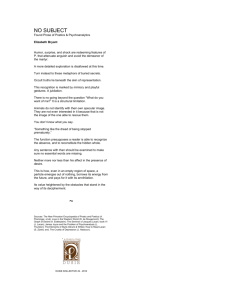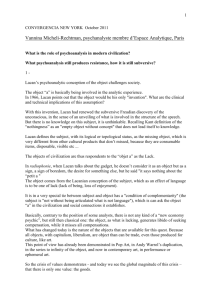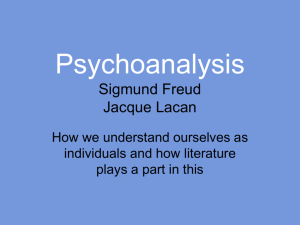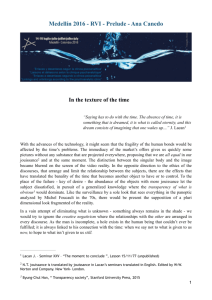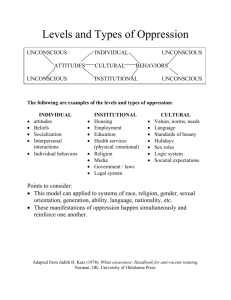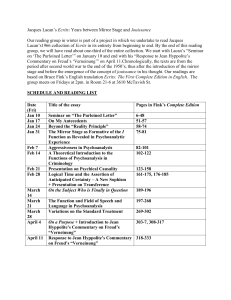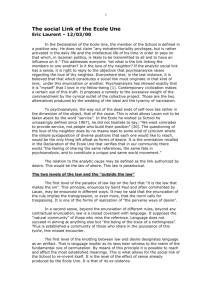From the Subject of Science to the Subject of the Unconscious
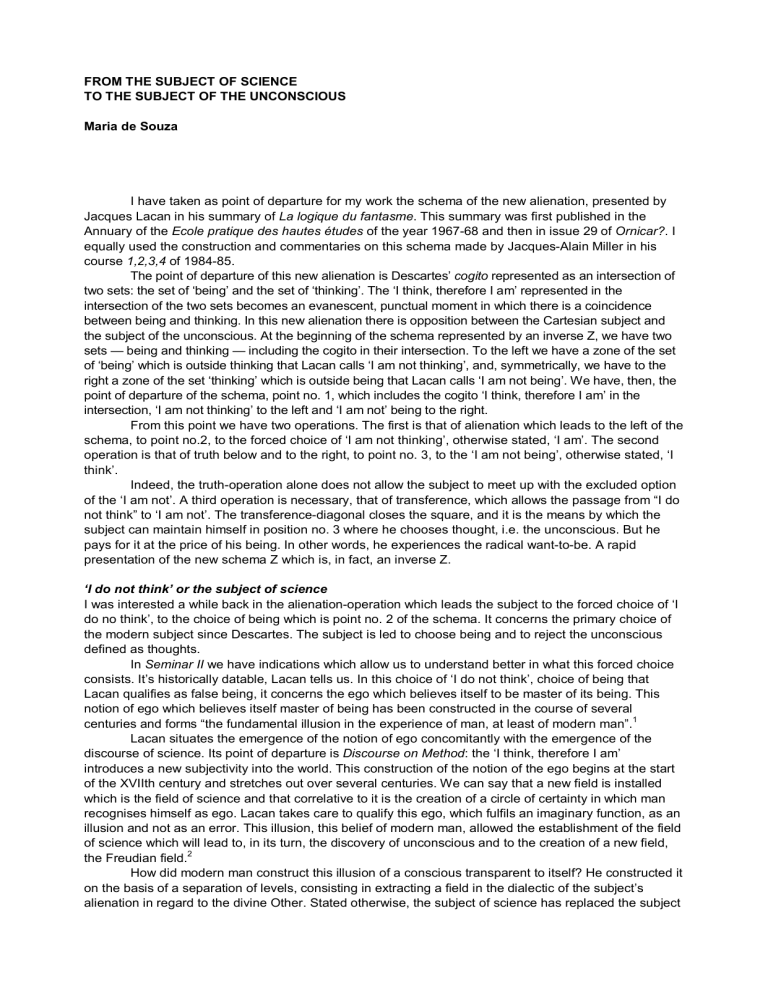
FROM THE SUBJECT OF SCIENCE
TO THE SUBJECT OF THE UNCONSCIOUS
Maria de Souza
I have taken as point of departure for my work the schema of the new alienation, presented by
Jacques Lacan in his summary of
La logique du fantasme
. This summary was first published in the
Annuary of the
Ecole pratique des hautes études
of the year 1967-68 and then in issue 29 of
Ornicar?
. I equally used the construction and commentaries on this schema made by Jacques-Alain Miller in his course
1,2,3,4
of 1984-85.
The point of departure of this new alienation is Descartes’ cogito
represented as an intersection of two sets: the set of ‘being’ and the set of ‘thinking’. The ‘I think, therefore I am’ represented in the intersection of the two sets becomes an evanescent, punctual moment in which there is a coincidence between being and thinking. In this new alienation there is opposition between the Cartesian subject and the subject of the unconscious. At the beginning of the schema represented by an inverse Z, we have two sets — being and thinking — including the cogito in their intersection. To the left we have a zone of the set of ‘being’ which is outside thinking that Lacan calls ‘I am not thinking’, and, symmetrically, we have to the right a zone of the set ‘thinking’ which is outside being that Lacan calls ‘I am not being’. We have, then, the point of departure of the schema, point no. 1, which includes the cogito ‘I think, therefore I am’ in the intersection, ‘I am not thinking’ to the left and ‘I am not’ being to the right.
From this point we have two operations. The first is that of alienation which leads to the left of the schema, to point no.2, to the forced choice of ‘I am not thinking’, otherwise stated, ‘I am’. The second operation is that of truth below and to the right, to point no. 3, to the ‘I am not being’, otherwise stated, ‘I think’.
Indeed, the truth-operation alone does not allow the subject to meet up with the excluded option of the ‘I am not’. A third operation is necessary, that of transference, which allows the passage from “I do not think” to ‘I am not’. The transference-diagonal closes the square, and it is the means by which the subject can maintain himself in position no. 3 where he chooses thought, i.e. the unconscious. But he pays for it at the price of his being. In other words, he experiences the radical want-to-be. A rapid presentation of the new schema Z which is, in fact, an inverse Z.
‘I do not think’ or the subject of science
I was interested a while back in the alienation-operation which leads the subject to the forced choice of ‘I do no think’, to the choice of being which is point no. 2 of the schema. It concerns the primary choice of the modern subject since Descartes. The subject is led to choose being and to reject the unconscious defined as thoughts.
In
Seminar II
we have indications which allow us to understand better in what this forced choice consists. It’s historically datable, Lacan tells us. In this choice of ‘I do not think’, choice of being that
Lacan qualifies as false being, it concerns the ego which believes itself to be master of its being. This notion of ego which believes itself master of being has been constructed in the course of several centuries and forms “the fundamental illusion in the experience of man, at least of modern man”.
1
Lacan situates the emergence of the notion of ego concomitantly with the emergence of the discourse of science. Its point of departure is
Discourse on Method
: the ‘I think, therefore I am’ introduces a new subjectivity into the world. This construction of the notion of the ego begins at the start of the XVIIth century and stretches out over several centuries. We can say that a new field is installed which is the field of science and that correlative to it is the creation of a circle of certainty in which man recognises himself as ego. Lacan takes care to qualify this ego, which fulfils an imaginary function, as an illusion and not as an error. This illusion, this belief of modern man, allowed the establishment of the field of science which will lead to, in its turn, the discovery of unconscious and to the creation of a new field, the Freudian field.
2
How did modern man construct this illusion of a conscious transparent to itself? He constructed it on the basis of a separation of levels, consisting in extracting a field in the dialectic of the subject’s alienation in regard to the divine Other. Stated otherwise, the subject of science has replaced the subject
of religion which is alienated in the desire of the Other. Misrecognising the relations of causality, the subject of religion busied himself in deciphering the enigma of the Other’s desire. This separation of levels has been conducted along the path of scientific atheism which has been a way of recuperating for man’s being whatever was concentrated in the divinity under the aegis of supreme Being. Lacan compares this process which presides over the emergence of the modern subject to the transformation of an absolute monarch into a constitutional monarch.
3 Stated otherwise, the ego which thinks that it’s a little constitutional monarch replaces the absolute divine Other. This comparison is very nice, for we have taken part in the passage from absolute monarchy to constitutional monarchy in the political and institutional history of countries in which this new subjectivity was constructed. We have taken part in the replacement of an absolute monarch whose rule was divine — he was the representative of God on earth — to a very diminished king whose prerogatives are defined in a contract.
We have, therefore, as essential correlate to the appearance of the field of science the establishment of a new subjectivity, that Lacan calls the modern subject, founded on an illusion of a consciousness transparent to itself. This forced choice of modern man which he qualifies as ‘I do not think’ includes, nevertheless, a certain mooring in being. We can denominate this point no. 2 of the schema described at the beginning as the subject of science or again the field of science.
‘I am not’ or the subject of the unconscious
The constitution of the field of science was a requisite preliminary to the discovery of the unconscious which, Lacan tells us, could only be discovered a certain time after the emergence of the subject of science. Why? Because the discovery of the unconscious includes a decentering in relation to the illusion in the experience of modern man. “The unconscious entirely escapes this circle of certainties in which man recognises himself as ego”.
4 Freud discovers a subject outside the subject of science. He discovers a perfectly articulated knowledge for which no subject is responsible. It concerns a thought outside the subject, a thought in which ‘I am not’.
This subject of the unconscious is represented in the schema at point no. 3, denominated ‘I am not’, otherwise stated, ‘I think’. In his writing
Concerning Psychoanalysis in its Relations with Reality
,
Lacan qualifies this place, this point no. 3 of the schema, as being the place of the truth of the subject’s alienation. Renunciation of this ‘I am’, that is, of this “I do not think”, is the forced choice of modern man, and it implies as consequence the rejection of the subject in ‘disbeing’ [ désêtre
].
5 The subject pays for its thoughts at the price of its existence. How can a subject maintain itself in that place? By means of transference which in the schema is represented by the diagonal that closes the square. Transference is the operation which allows the passage from alienation to truth.
6
The discovery of the unconscious has given rise to the constitution of a new field which is the
Freudian field. Freud encountered the unconscious in the mode of a stumbling stone: dream, failed action, joke. The unconscious includes this fugitive aspect, and when it shows itself, the subject is overwhelmed, he cannot say ‘I am’. How can a subject account for this knowledge without a subject?
The answer to this question has two aspects. The first concerns logic: “it’s not from the discourse of the unconscious that we are going to harvest the theory that accounts for it”.
7 The second aspect is ethical.
In
Seminar XI
Lacan situates the unconscious as ‘preontological’, “it is neither being nor non-being, it is non-reaslised”.
8 “The unconscious always manifests itself as what is vacillating in a cut of the subject”, 9 and this field opened by Freud is always at risk of being covered over again.
To give to the unconscious an ethical status implies for those who have a duty to it — that is, those who have encountered the analytical cause — that it be worthy of Spinoza’s just man who is the one who when he covets a good for himself desires it for the others as well.
10
If we take up again the amusing phrase in which Lacan compares the replacement of the subject of religion by the subject of science in the passage from the absolute monarch to the constitutional monarch, we can ask ourselves what could correspond to the passage from the point no. 2 to the point no. 3 of the schema, to the passage from the subject of science to the subject of the unconscious. I would say that it does not concern the republic but the school, a school susceptible of proscribing infatuation so that the field remains open and that the work can continue.
To finish, I would say that the schema on which I made this little commentary includes a fourth place, a terminal point, which puts itself beyond psychoanalysis. It concerns the point at which the theory and practice of the pass is constituted and elaborated. On this fourth point it concerns a new field about which Lacan said in
Seminar XVII
: “Alas, one will never call it the Lacanian field, for I will surely not have the time even to outline its foundations”.
11 It’s about the field of jouissance
.
To tear some knowledge from the real has a price and costs dearly. To add some knowledge to the real — by means of invention — also has its price to pay. In
Science and Truth
, Lacan evokes the drama of the scholar, the subjective drama that each crisis costs, each time that knowledge advances a few millimetres, gaining terrain over non-knowledge.
12 This price is not paid uniquely by the one who takes a step in the conquest of knowledge. We all pay it, such as we are. Each one pays his share, proportional to his position as subject. What is the position of the subject? The subject is not the individual. “The subject goes exactly as far as the truth it can reach”.
13
Translated by Richard Klein
1. J. Lacan,
Seminar II
,
The Ego in Freud’s Theory and in the Technique of Psychoanalysis
, Trans.
S. Tomaselli, Cambridge University Press, 1988, p. 4.
2.
Ibid
., pp.5-7.
3.
Ibid
., p.48.
4.
Ibid
., p.7.
5. J. Lacan,
De la psychanalyse dans ses rapports avec la réalité
in
Scilicet
No 1, Paris, Seuil,
1968, pp. 58-59.
6. J.-A. Miller,
Lacanian Orientation 1, 2, 3, 4
, Course of 22 May 1985, Departement de psychanalyse.
7. J. Lacan,
La méprise du sujet supposé savoir
in
Scilicet
No 1, op.cit., p.32.
8. J. Lacan,
Seminar XI
,
The Four Fundamental Concepts of Psychoanalysis
, Trans. A. Sheridan,
The Hogarth Press, 1977, pp. 29-30.
9.
Ibid
., p. 28.
10. B. Spinoza,
Ethique
,
Oeuvres
, 4 vol., Paris, Barnier, 1964-66,
Tome III
, p.252.
11. J. Lacan,
Le Séminaire XVII
,
L’Envers de la psyhcanalyse
, Paris, Seuil, 1991, p. 93.
12. J. Lacan,
La science et la vérité
in
Ecrits
, Paris, Seuil, 1966, pp.869-870.
13. J. Lacan,
Function and Field of Speech and Language
in
Ecrits
:
A Selection
, trans. A. Sheridan, p.55.
This text was originally published in
La Cause freudienne
No 42, 1999.
Copyright © by the Author. This text from the website of the London Society of the New Lacanian School, at http://www.londonsociety-nls.org.uk. Permission to circulate material from this site must be sought from the LSNLS. All rights reserved. Please include this portion of the text in any printed version of this paper.
